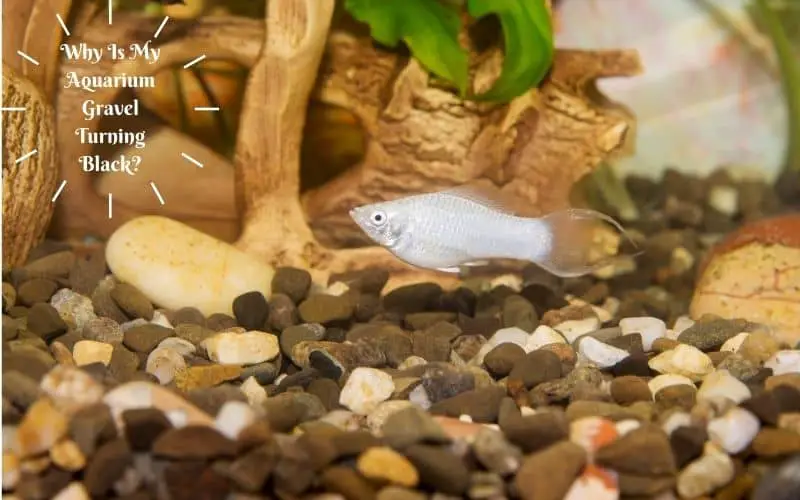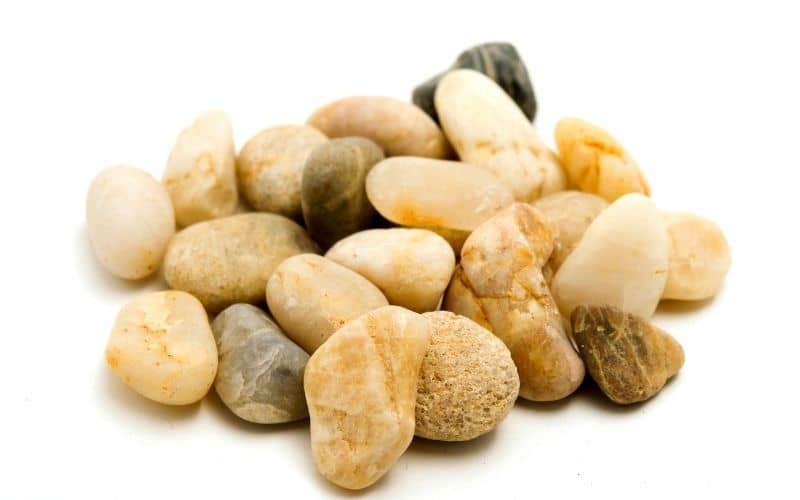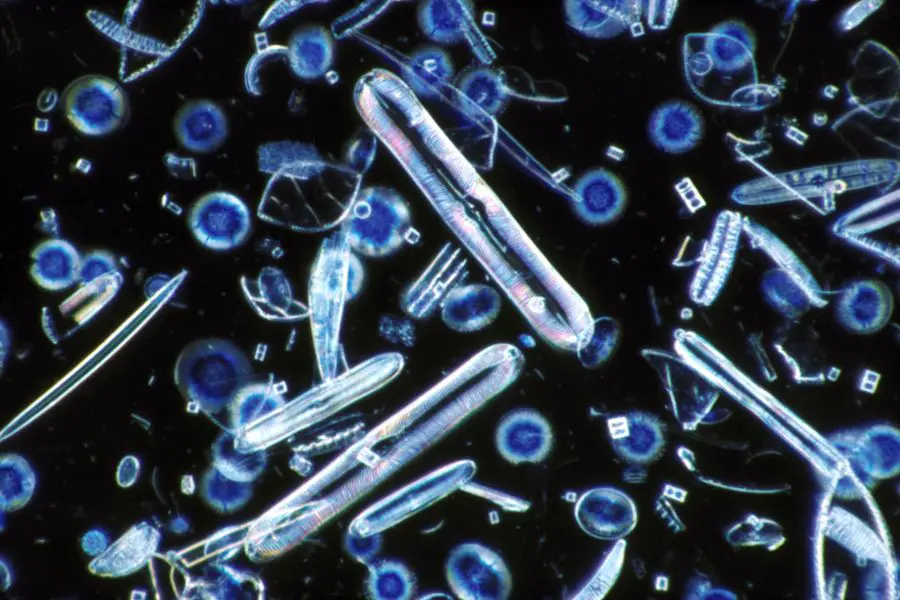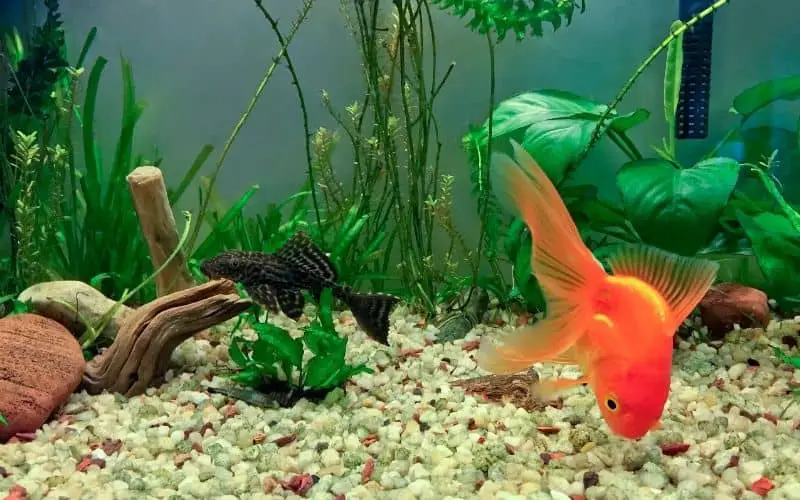Aquarium Gravel Turning Black is a common problem and it can be frustrating to see this happen. There are three possible reasons for black gravel. Those are
01. Algae: More possibly black beard algae that built up on the gravel. When algae growth takes place, it’s hard to get rid of it. So, even after removing the black stuff on your gravel, it will come back within days.
02. Fish Waste: When Debris and leftover food settle on the gravel, and you don’t vacuum them often, the color of your gravel may turn black. Sometimes dead fish build up a fungus called Saprolegnia which also is black.
03. Dye: The dye from gravel leeches into the water, thus returning the gravel to its natural color.
You can solve this very easily. Let’s find out how.

How To Stop It?
Jump To
- 1 How To Stop It?
- 2 Can Aquarium Gravel Go Bad?
- 3 Black Aquarium Gravel Turning White
- 4 Why Is My Aquarium Gravel Turning Brown?
- 5 Are Diatoms Bad For Fish?
- 6 Why Is My Aquarium Gravel Turning Green?
- 7 Is Green Algae Bad For Fish?
- 8 Why Are the Rocks in My Aquarium Turning Black
- 9 Fish Tank Decorations Turning Black
- 10 Black Spots on Aquarium Glass
- 11 Black Spots On Aquarium Plants
- 12 Are Black Algae Harmful In Aquarium?
- 13 What Happens If You Don’t Rinse Aquarium Gravel?
- 14 How Do I Get Rid Of Black Algae In My Tank?
- 15 How Often Should I Clean Aquarium Gravel?
- 16 Is Black Gravel Good For Aquarium?
- 17 Algae Eating Fish, Shrimps, and Snails
- 18 Black Algae Eating Fish
- Algae: You have to vacuum the gravel more often and put some live plants that absorb Nitrogens from the water. And also, put some algae-eating fish or shrimp to fasten up the algae-removing process. Getting rid of Algae is really hard, but if you consistently vacuum-keeping plants and algae-eating fish, the algae growth will control.
- Fish Waste: The only way to remove fish waste is to vacuum it often. If you are already vacuuming, then double it up. If you suspect Saprolegnia-infected dead fish in your tank, you should remove the dead fish immediately as the fungus may affect live fish with dead tissues.
- Dye: Suppose the gravel color changes while a black layer settles on the gravel; first of all, vacuum it. If the natural color of the gravel satisfies you, you can keep it. Or else, it’s time to change the gravel. Look for any changes in your fish as the dye may be toxic for your fish.
Can Aquarium Gravel Go Bad?
The gravel itself can not go bad. It’s the condition in the tank when there is insufficient cleaning. Even though you vacuum the tank often, there may be wasted food and poop that a vacuum can not reach.
This debris and wasted food settle deep inside the gravel, thus producing Ammonia and Nitrates and polluting the water. Ammonia and Nitrates are toxic for your fish. So, you have to find a solution to remove them from the water.
Black Aquarium Gravel Turning White
If you see any black Aquarium gravel turning white, it is because of the dye from the gravel leeching into the water. This color change is not a good sign for your fish. You should remove the fish from your tank and clean the Aquarium, removing all of your gravel.
Wash your gravel until it doesn’t have any more black dye and put them back in your Aquarium. Cycle the Aquarium for a few days without fish to check if the color of your gravel still changes. Then add some hardy fish to the Aquarium for a few days. If things go well, place the other fish back in your Aquarium.

Why Is My Aquarium Gravel Turning Brown?
If your aquarium gravel is turning brown, it’s probably because of the brown algae called Diatoms. Brown algae usually come to newly set up tanks when not enough lighting and from overfeeding.
The good news is that you can get rid of them quickly. Diatoms don’t adhere firmly to the tank surface so that you can wipe it away easily. You can vacuum the diatoms built-up on the gravel.
Clean the tank remove diatoms for a few days, limit feeding your fish and leave the lights on your Aquarium for at least 8 hours per day so that you can eliminate brown algae from your Aquarium.
Are Diatoms Bad For Fish?
Diatoms are not harmful to your fish if you keep them under control. Some fish do like to eat diatoms and help clean your tank from algae. However, if the growth of diatoms exceeds, it will block the lights and monopolize space. It will increase the dead and decayed population causing increased toxins in the water.
Overgrown diatoms will also absorb more oxygen from water, leaving less oxygen for your fish. This way, your fish will get affected by diatoms.

Why Is My Aquarium Gravel Turning Green?
If your aquarium gravel is turning green, it is because green algae build up on your gravel. If the algae build-up is small, you can put algae-eating fish like Chinese Algae Eater or a shrimp such as Amano Shrimp.
They will eat algae and control growth. But if your tank is full of green algae, you have to remove them yourself. Scrape the algae from the tank surfaces with a scraper. Remove the gravel from the tank, scrub them with a rough sponge, and then wash them with a hydrogen peroxide solution before putting them back in the tank. Getting rid of green algae is hard. You have to take some measures to reduce algae growth.
Growing floating plants like Pothos will help a lot as they reduce Ammonia and Nitrate levels in your Aquarium. Controlling light levels and injecting CO2 will also help reduce algae growth.
Is Green Algae Bad For Fish?
Green algae are not bad for fish when they don’t overgrow. They often become good healthy food for omnivore fish, shrimp, and snails. Many fish use them for the mating process, to hide from predators, and to lay eggs.
Green algae usually indicate good water quality. If you have way too many algae in your tank, they might use much oxygen at night, leaving your fish to suffocate. They also absorb nutrients in the water intended for your aquarium plants. So, too much green algae are bad for fish.
Why Are the Rocks in My Aquarium Turning Black
If the rocks in your Aquarium are turning black, it is most likely the black beard algae. The chances are that black beard algae have spread to the other parts of your Aquarium too. Black beard algae are not harmful to the fish. Actually, fish loves to hide behind this algae.

However, if you want to remove black beard algae on your rocks, remove the rocks and scrape them first. Then wash them with Hydrogen Peroxide solution. Do this for other affected decorations as well.
Keep in mind that this treatment will affect the delicate live plants of your Aquarium. Introduce some algae-eating fish to your tank, add some floating aquarium plants and increase CO2 levels for about a week or so. By following these steps, you can get rid of Black Beard Algae from your Aquarium.
Fish Tank Decorations Turning Black
If your fish tank decorations are also turning black, the reason is the same as rocks; black beard algae. Follow the steps described above to remove black beard algae from your decorations.
Black Spots on Aquarium Glass
Black (or dark green/brown) spots on Aquarium glass are indeed Green Spot Algae. They usually come in planted tanks and when the tank has high phosphate levels.
You can scrape the green spot algae with a credit card or an aquarium scraper, but to get rid of them, you have to lower the Phospate level of your Aquarium. The easiest way to do that is to use a Phospate-removing product. Otherwise, you’ll have to change water frequently until you notice a significant reduction in algae growth.
Black Spots On Aquarium Plants
Black spots on aquarium plants occur because of green spot algae. Unfortunately, the only way to eliminate green spot algae from aquarium plants is to remove the affected part. Usually, green spot algae grow on the leaves of aquarium plants.
So, cutting them and removing them from the Aquarium is the best solution if this happens.
Are Black Algae Harmful In Aquarium?
Are black algae harmful to fish? No. They don’t harm any marine life, and fish like to hide behind the flowing hairs. Are black algae harmful to aquarium plants? Yes.
When algae growth exceeds the level that they cover up all the plants, the plants will not get enough light and nutrients because of algae. Hence, eventually, plants die because of starvation. So, the answer to this question would be both yes and no.
What Happens If You Don’t Rinse Aquarium Gravel?
If you don’t rinse aquarium gravel well, the dust and other compounds on the gravel mix up with the water, hence making a cloud in your Aquarium. Many fish experts advise washing gravel at least three times before accompanying them into the tank because the dust and other compounds may harm the fish.
If you have already done it, do not add any fish yet. Put some startup bacteria, turn on the filter and cycle the Aquarium for about seven days. Or else, remove the most cloudy water, take everything back and wash, and then put them into the Aquarium again.
You should not put any fish into the cloudy water.
How Do I Get Rid Of Black Algae In My Tank?
There are several methods to get rid of black beard algae in your tank. The easiest way is to treat the tank with Hydrogen Peroxide. Read on to how to do it.
- Give an H2O2 Bath to Infested Decorations: You can remove any affected décor or plants and soak them in a 3% Hydrogen Peroxide solution for about 3 minutes. Then, thoroughly rinse the items with fresh water and put them into the tank again.
- Introduce Algae Eaters: Some species of fish, shrimp, and snails can eat algae. If you introduce them into your tank in the early stages of algae growth, they will control and reduce the algae growth. However, if you overfeed them, they will happily eat your food and will not look at the algae. So, to control algae growth, you should limit feeding for your fish.
- Boost CO2 level in the Aquarium: If you have live plants in your Aquarium, you can try this method. CO2 helps the growth of aquarium plants. Then the plants outcompete algae growth.
- Regulate Phospate in Your Aquarium: Decayed substances such as dead plants, dead fish, wasted food, and other fish wastes develop Phosppate in your Aquarium. Increased Phosphate levels help algae growth. When you keep Phospate levels down by cleaning the tank regularly, you can eventually get rid of black algae.
- Treating the tank with H2O2: When the infestation is out of control, you can put 10ml of neat 3% hydrogen peroxide per 15 gallons per day for about three days. There is a possible risk for your fish and other inhabitants. So, please remove them into another tank temporally. If black beard algae come again, repeat the process.
How Often Should I Clean Aquarium Gravel?
It would be best if you cleaned aquarium gravel at least once a month. Using an aquarium vacuum is enough for this task. When an algae infestation, you will have to clean your gravel more often until it controls.
In addition, you should test the water condition once per month to check the ammonia, nitrate, and pH levels of your Aquarium.

Is Black Gravel Good For Aquarium?
There’s no particular reason to use black gravel for your Aquarium unless it is for decoration. When using colored gravel for your Aquarium. Also please don’t go for cheap ones as they may be colored with cheap dyes that are toxic to fish.
Always buy colored gravel from a reputed brand, and you will be ok. Regardless of the brand, you always have to wash the gravel thoroughly before putting them into the tank. However, some gravel comes with active bacteria that you should not rinse. You can put those gravel into your Aquarium immediately.
Algae Eating Fish, Shrimps, and Snails
Here is a list of the best algae-eating fish, shrimps, and snails.
- Siamese Algae Eater
- Bristlenose Pleco
- Mollies
- Chinese Algae Eater
- Twig Catfish
- American Flag Fish
- Otocinclus Catfish
- Whiptail Catfish
- Nerite Snail
- Ramshorn Snail
- Mystery Apple Snail
- Malaysian Trumpet Snail
- Rabbit Snail
- Amano Shrimp
- Cherry Shrimp
- Ghost Shrimp
- Bamboo Shrimp
Black Algae Eating Fish
There are very few fish and shrimp that eat black algae. They are,
- Siamese Algae Eater
- American Flag Fish
- Amano Shrimp
Among these species, Amano shrimp is extraordinary because it can also feed on many other algae types and blue-green algae (which is actually a bacteria) as well.
Video Credit to: Danny’s Aquariums
